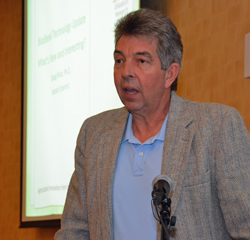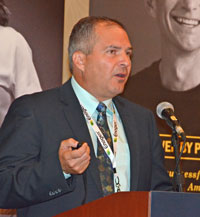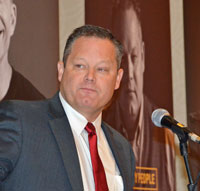The last batch of Republican presidential candidates took the Soapbox stage during the last weekend of the Iowa State Fair.
 New Jersey Governor Chris Christie (R) took a different approach and only answered questions. His overall statement was that the government needs to enforce the laws currently in place – not just the laws we like- but all laws. Speaking of a law he doesn’t like: the Clean Power Plan. His state has submitted a request to end the program and believes that each state should set their own legislation and develop their own plans. For example, he noted that Iowa is a land of wind, but in the most dense state in the country, solar works better. New Jersey uses solar, natural gas and nuclear and has already met their 2020 clean power goals.
New Jersey Governor Chris Christie (R) took a different approach and only answered questions. His overall statement was that the government needs to enforce the laws currently in place – not just the laws we like- but all laws. Speaking of a law he doesn’t like: the Clean Power Plan. His state has submitted a request to end the program and believes that each state should set their own legislation and develop their own plans. For example, he noted that Iowa is a land of wind, but in the most dense state in the country, solar works better. New Jersey uses solar, natural gas and nuclear and has already met their 2020 clean power goals.
When asked about the Renewable Fuel Standard (#RFS), he said he supports the RFS. The problem is that the Obama Administration along with the EPA is not enforcing the law. He stressed that he is a huge supporter of more energy options and the RFS provides just this and he called out to other candidates to make up their mind on their RFS position.
Listen to why New Jersey Governor Chris Christie wants to be president: Chris Christie at the Iowa State Fair
U.S. Senator from Texas Ted Cruz (R) took much of his time to crack jokes about the Democrats and the rest of his time to talk about all the U.S. government executive orders he would rescind along with government organizations he would dismantle including the IRS, Department of Education and all the other ABCs. And Cruz promised he will reign in the regulatory agencies that “descend like locusts on farms and ranches and small businesses.” As for energy, not sure if reigning in the EPA includes revisions (or trying to overturn) the Renewable Fuel Standard, Clean Power Plan or WOTUS.
the rest of his time to talk about all the U.S. government executive orders he would rescind along with government organizations he would dismantle including the IRS, Department of Education and all the other ABCs. And Cruz promised he will reign in the regulatory agencies that “descend like locusts on farms and ranches and small businesses.” As for energy, not sure if reigning in the EPA includes revisions (or trying to overturn) the Renewable Fuel Standard, Clean Power Plan or WOTUS.
Listen to why Texas U.S. Senator Ted Cruz wants to be president: Ted Cruz at the Iowa State Fair
 Louisiana Governor Bobby Jindal (R) went back to the “by the bootstraps” message. He said this election is all about the American dream, like most other candidates, and how to bring it back. He wants to evolutionize the economy, stop illegal immigration, buff up our military power and curb the power of regulatory agencies such as the EPA who is regulating the “water in our backyards”. He concluded, “I ask you to believe again. Let’s rescue the idea of America before it slips away.”
Louisiana Governor Bobby Jindal (R) went back to the “by the bootstraps” message. He said this election is all about the American dream, like most other candidates, and how to bring it back. He wants to evolutionize the economy, stop illegal immigration, buff up our military power and curb the power of regulatory agencies such as the EPA who is regulating the “water in our backyards”. He concluded, “I ask you to believe again. Let’s rescue the idea of America before it slips away.”
Listen to why Louisiana Governor Bobby Jindal wants to be president: Bobby Jindal at the Iowa State Fair
 The very last presidential candidate to take the stage was Mark Everson (R) who is the former IRS Commissioner. Who better to call for tax reform than the person who knows it best. He said that this campaign, this country, needs a new type of politician (one could argue Donald Trump and Ben Carson are proving this to be true). In that he meant one who isn’t a life-long politician but rather one who knows how to run a business. He stressed that tax reform would get the economy going.
The very last presidential candidate to take the stage was Mark Everson (R) who is the former IRS Commissioner. Who better to call for tax reform than the person who knows it best. He said that this campaign, this country, needs a new type of politician (one could argue Donald Trump and Ben Carson are proving this to be true). In that he meant one who isn’t a life-long politician but rather one who knows how to run a business. He stressed that tax reform would get the economy going.
Listen to why Mark Everson, former IRS Commissioner wants to be president: Mark Everson at the Iowa State Fair
And thus concludes our #Energy and #Ag coverage of the Des Moines Register’s Presidential Soapbox series at the Iowa State Fair. The election is long so the candidates (especially the Democratic candidates) who chose not to address these concerns head on will have some time to get their messages straight before the caucus tentatively scheduled for Monday, February 1, 2016.
 Sen. Roy Blunt (R-MO) hopes EPA will listen to the concerns of the industry. “I think it’s important that we become as energy self-sufficient as we can and renewables are an important part of that,” said Blunt during an interview at the fair. “We have great potential in more American energy of all kinds and the potential of how much we can add to that in renewables and what that does to the ag economy and production agriculture generally in terms of that product being available not just for fuel but for food is important.”
Sen. Roy Blunt (R-MO) hopes EPA will listen to the concerns of the industry. “I think it’s important that we become as energy self-sufficient as we can and renewables are an important part of that,” said Blunt during an interview at the fair. “We have great potential in more American energy of all kinds and the potential of how much we can add to that in renewables and what that does to the ag economy and production agriculture generally in terms of that product being available not just for fuel but for food is important.” Rep. Vicky Hartzler (R-MO) says EPA tried to come up with a compromise with the proposed rule. “It was better than we hoped in some ways, but it was worse than we had hoped,” said Hartzler. “I think they should have just followed the law and continued on allowing a greater percentage of our fuel to come through renewables. I’m hopeful that we’ll somehow be able to increase that level.”
Rep. Vicky Hartzler (R-MO) says EPA tried to come up with a compromise with the proposed rule. “It was better than we hoped in some ways, but it was worse than we had hoped,” said Hartzler. “I think they should have just followed the law and continued on allowing a greater percentage of our fuel to come through renewables. I’m hopeful that we’ll somehow be able to increase that level.”














